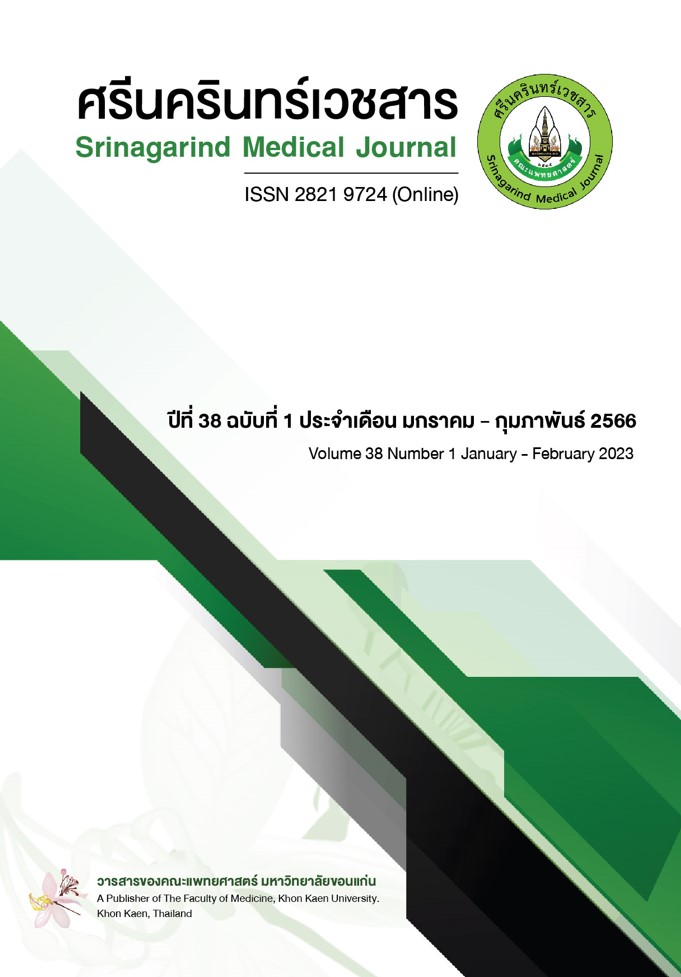Performance of Existing Pediatric Early Warning System (PEWS) at Sikhoraphum Hospital
Keywords:
pediatric patients, pediatric early warning scoresAbstract
Background and Objective: Pediatric patients are more likely to have unplanned crises. Identifying critically at-risk pediatric patients at the time of arrival will help them receive timely and appropriate care. This study aimed to determine the effectiveness of the pediatric early warning system (PEWS) of Sikhoraphum hospital.
Method: A retrospective cohort study was conducted. The sample consisted of patients aged over 1 month to 15 years, and whose medical records were all assessed with the PEWS systems between January to December 2021. The instruments was PEWs record forms, and the content validity index was at 1.00. Data were assessed using diagnostic tests as sensitivity, specificity and discrimination areas under the ROC curve (AROC).
Result: A total of 123 children were included for analysis. The mean age was 4.4 years (standard deviation, SD = 4.24). The cut-off point for PEWS score above 2 points; to predict the need for admission with a sensitivity of 73.17 %, specificity of 46.34 % and AROC for predicting admission were 66.11 % (95%CI 0.5609-0.7611); to predict the need for PICU admission with a sensitivity of 95.56 %, specificity of 50.00 % and AROC for predicting PICU admission were 85.36 % (95%CI 0.7846-0.9224); to predict the need for refer with a sensitivity of 80.77 %, specificity of 37.11% and AROC for predicting refer were 64.85 % (95%CI 0.5315-0.7654)
Conclusion: It is recommended that PEWS is a good predictor at risk for PICU admission, which can help with diagnosis and catching symptoms prior to deterioration in order to improve the efficiency and effectiveness of patient care.
References
Chavisa Rassameehirun. The use of the precritical care system in the care of pediatric patients. [online system] Bangkok: Department of Pediatrics. Faculty of Medicine, Chulalongkorn University; 2021 [cited May 7, 2021]. Available from: https://ped.md.chula.ac.th/wp-content/uploads/2021/09/24_CUPA2021-ebook.pdf
Paterson R, MacLeod D, Thetford D, Beattie A, Graham C, Lam S, et al. Prediction of in-hospital mortality and length of stay using an early warning scoring system: clinical audit. Clin Med (Lond) 2006;6(3):281.
Royal College of Physicians [Internet].London.National Early Warning Score (NEWS): standardising the assessment of acute-illness severity in the NHS [updated 2020; [cited July 12, 2022].report of a working party. 2022. Available from: https://www.rcplondon.ac.uk/projects/outputs/national-early-warning-score-news-2
Chapman SM, Maconochie IK. Early warning scores in paediatrics: an overview. Arch Dis Child 2019;104(4):395-9.
De Vries A, Draaisma JM, Fuijkschot J. Clinician perceptions of an early warning system on patient safety. Hosp Pediatr 2017;7(10):579-86.
Jensen CS, Nielsen PB, Olesen HV, Kirkegaard H, Aagaard H. Pediatric early warning score systems, nurses perspective–a focus group study. J Pediatr Nurs 2018;41:e16-e22.
Lambert V, Matthews A, MacDonell R, Fitzsimons J. Paediatric early warning systems for detecting and responding to clinical deterioration in children: a systematic review. BMJ Open 2017;7(3):e014497.
The Healthcare Accreditation Institute (Public Organization). Patient safety goals: SIMPLE Thailand 2018. Nonthaburi: The Healthcare Accreditation Institute (Public Organization); 2018.
The Healthcare Accreditation Institute (Public Organization). Hospital and Healthcare Standards 4th edition. Nonthaburi: The Healthcare Accreditation Institute (Public Organization); 2019.
Jarupan Tan-Aree. Early warning score efficacy: PEWS in the pediatric ward. Kamphaeng Phet Hospital. Thai J Pediatr 2016;55(3):196–200.
Tanu Tangsricharoen, Suparat Kanjanavanit. Performances of the Pediatric Early Warning Score (PEWS) to predict early deaths within 24 hours and causes of death in pediatric intensive care unit. J Nakornping Hosp 2018;9(2):28-40.
Pimpan Panpoh. Surveillance and care system for patients with context-adjusted deterioration (Modified Early Warning Score) in the inpatient department of Wat Bot Hospital Phitsanulok Province. JPMAT 2012;2(2):166-77.
Watchara Konkaew, Wanna Satvinit, Apinan Choowong, Kanokwan Sinlukkatiphip. Development of a surveillance model for change symptoms female internal medicine ward Photharam Hospital Ratchaburi Province 2009. Ratchaburi: Photharam Hosp; 2009
Uraiwan Kaewpetch. The Effectiveness of the Modified Early Warning Score (MEWS) for Surveillance of Patients before Entering Crisis Inpatient Department Sikhio Hospital Nakornratchasima Province. Reg11 Med 2021;35(1):1-11.
Daniel WW, Cross C. Nonparametric and distribution-free statistics. Daniel WW Biostatistics: a foundation for analysis in the health sciences 6th ed New York: John Wiley & Sons Inc, 1995:567-631.
Chaiyakulsil C. Validation of Thammasat Pediatric Early Warning Score for Prediction of Pediatric Intensive Care Unit Admission. Thammasat Med J 2020;20(3):215-25.
Pailin Nadsantia; Worakanya Polarsa, Arisa Sanmit. Developing the Clinical Practice Guideline of Pediatric Early Warning System in Sakon Nakhon Hospital. J Sakon Nakhon Hosp 2020;23(1):1-14.
Somporn Poolpanitoopatum, Nattachai Anantasit, Somying Goonthon, Pharuhad Pongmee. The effectiveness of the utilization of the rapid response system in pediatric wards at Ramathibodi Hospital. JOPN 2020;12(2):348-59.
Nittayaporn Channakorn, Tasanee Daekhunthod, Uraiwan Sridama, Piyanuch Boonkong. Development of Early Warning Signs Assessment Model for Adult Critical Patients at Sakon Nakhon Hospital. J Nurs Divis 2020;47(1):39-58.
Downloads
Published
How to Cite
Issue
Section
License
Copyright (c) 2023 Srinagarind Medical Journal

This work is licensed under a Creative Commons Attribution-NonCommercial-NoDerivatives 4.0 International License.




